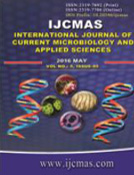


 National Academy of Agricultural Sciences (NAAS)
National Academy of Agricultural Sciences (NAAS)

|
PRINT ISSN : 2319-7692
Online ISSN : 2319-7706 Issues : 12 per year Publisher : Excellent Publishers Email : editorijcmas@gmail.com / submit@ijcmas.com Editor-in-chief: Dr.M.Prakash Index Copernicus ICV 2018: 95.39 NAAS RATING 2020: 5.38 |
The use of extracellular enzyme systems from wood decaying fungi are now growing very fast for bioremediation of synthetic and toxic dyes from environment. In view of this, present study was undertaken for decolorization of two synthetic industrial viz. congo red and brilliant green using wood rot fungal cultures. Fifty five wood rotting fungal cultures were tested qualitatively for production of extracellular lignolytic enzymes. Selected cultures were used for testing the in vitro dye removal potential in dye containing broth. Samples were withdrawn periodically and percent decolorization was calculated. The fungal cultures removed the dye from the media either by accumulating it in mycelia (bio-sorption) or by metabolizing it to some non-coloured components. The cultures varied in their dye decolorizing potential, showing 50.21-97.37% decolorization of brilliant green within 24 d. All the selected cultures showed complete bio-sorption of congo red dye within one month. The efficient strains were further selected for the production of various enzymes involved in the dye decolorization and crude enzyme activities in culture supernatantes were calculated. In all the cases, maximum extracellular laccase, lignin peroxidases and Mn dependent peroxidase activities were observed within 15 to 18 d of incubation in culture supernatant. Light microscopy and phase contrast microscopy clearly revealed bio-sorption of the dye by fungal cultures in the photomicrographs. Among various cultures tested, the potential isolate showing maximum dye decolorizing/ bioabsorbing ability identified as Ganoderma sp.
 |
 |
 |
 |
 |